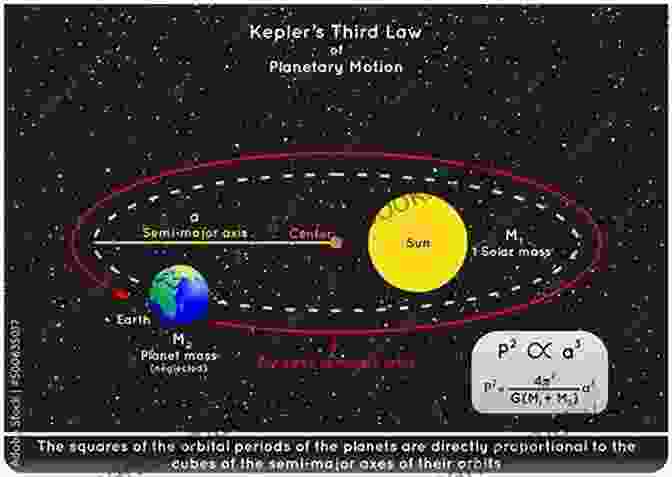The Kepler Problem and the Principia: Unraveling the Mysteries of Celestial Motion

: The Quest to Understand the Heavens
For centuries, astronomers peered at the night sky, seeking patterns and explanations for the movements of celestial bodies. From the ancient Greeks to the Renaissance scholars, the quest to understand the heavens ignited the minds of countless thinkers. Among them, Johannes Kepler and Sir Isaac Newton emerged as key figures, unlocking fundamental insights into the nature of celestial motion.
Chapter 1: Kepler's Laws and the Birth of Planetary Astronomy
Johannes Kepler's groundbreaking work in the 17th century marked a turning point in astronomy. Through meticulous observations and calculations, he formulated three fundamental laws that govern the motion of planets around the Sun:
4.8 out of 5
| Language | : | English |
| File size | : | 4779 KB |
| Text-to-Speech | : | Enabled |
| Screen Reader | : | Supported |
| Word Wise | : | Enabled |
| Print length | : | 330 pages |
| Lending | : | Enabled |
- Law of Ellipses: Planets move in elliptical orbits around the Sun, with the Sun positioned at one of the foci.
- Law of Areas: A line connecting a planet to the Sun sweeps out equal areas in equal time intervals.
- Law of Periods: The square of a planet's orbital period is proportional to the cube of its average distance from the Sun.
Kepler's laws revolutionized the understanding of planetary motion, providing a quantitative framework for predicting the positions and velocities of celestial bodies.
Chapter 2: Newton's Principia and the Universal Law of Gravitation
Building upon Kepler's work, Sir Isaac Newton published his seminal work, "Principia Mathematica," in 1687. In this groundbreaking treatise, Newton introduced the concept of universal gravitation, a fundamental force that governs the motion of all objects in the universe. He formulated the equation:
F = Gm₁m₂/r²
where F is the gravitational force, G is the gravitational constant, m₁ and m₂ are the masses of the interacting objects, and r is the distance between them.
Newton's law of gravitation provided a unified explanation for a wide range of celestial phenomena, from the motion of planets to the tides on Earth. It established a foundation for predicting and understanding the behavior of objects throughout the universe.
Chapter 3: Mathematical Techniques for Solving the Kepler Problem
The Kepler problem, determining the motion of a planet around the Sun under the influence of Newton's gravitational force, is a challenging mathematical problem. This chapter explores various analytical and numerical techniques for solving the Kepler problem, enabling astronomers to calculate planetary orbits and design spacecraft trajectories.
Chapter 4: Applications in Space Exploration and Celestial Mechanics
The understanding of celestial motion gained from Kepler's laws and Newton's Principia has transformative applications in space exploration and celestial mechanics. This chapter discusses how these principles are used in:
- Designing spacecraft trajectories for missions to planets and other celestial bodies
- Determining the orbits of comets, asteroids, and other small bodies in our solar system
- Studying the dynamics of binary star systems and other gravitationally bound systems
Chapter 5: Historical Context and Cultural Impact
The development of celestial mechanics was not just a scientific endeavor but also a cultural phenomenon. This chapter examines the historical context and cultural impact of Kepler and Newton's work, exploring their influence on Enlightenment thought, the development of scientific methods, and the public's perception of the universe.
: The Enduring Legacy of Kepler and Newton
The contributions of Kepler and Newton to our understanding of celestial motion have had a profound impact on astronomy, physics, and human knowledge. Their groundbreaking work laid the foundations for modern celestial mechanics, enabling us to predict the behavior of planets, stars, and other celestial objects with remarkable accuracy.
"The Kepler Problem and the Principia" provides a comprehensive and engaging exploration of this fascinating subject, illuminating the scientific and cultural significance of Kepler's laws and Newton's Principia. It is an essential resource for students, researchers, and anyone interested in unraveling the mysteries of celestial motion.

Free Download Your Copy Today
4.8 out of 5
| Language | : | English |
| File size | : | 4779 KB |
| Text-to-Speech | : | Enabled |
| Screen Reader | : | Supported |
| Word Wise | : | Enabled |
| Print length | : | 330 pages |
| Lending | : | Enabled |
Do you want to contribute by writing guest posts on this blog?
Please contact us and send us a resume of previous articles that you have written.
 Book
Book Novel
Novel Page
Page Chapter
Chapter Text
Text Story
Story Genre
Genre Reader
Reader Library
Library Paperback
Paperback E-book
E-book Magazine
Magazine Newspaper
Newspaper Paragraph
Paragraph Sentence
Sentence Bookmark
Bookmark Shelf
Shelf Glossary
Glossary Bibliography
Bibliography Foreword
Foreword Preface
Preface Synopsis
Synopsis Annotation
Annotation Footnote
Footnote Manuscript
Manuscript Scroll
Scroll Codex
Codex Tome
Tome Bestseller
Bestseller Classics
Classics Library card
Library card Narrative
Narrative Biography
Biography Autobiography
Autobiography Memoir
Memoir Reference
Reference Encyclopedia
Encyclopedia Leah Zani
Leah Zani Rachel Ann Cullen
Rachel Ann Cullen Melissa D Burrage
Melissa D Burrage Irving Fisher
Irving Fisher Jacques Pepin
Jacques Pepin Jakob Schneider
Jakob Schneider Rachel Dwyer
Rachel Dwyer Kathleen E Woodiwiss
Kathleen E Woodiwiss William Meikle
William Meikle Joan Bess
Joan Bess Jack Andraka
Jack Andraka Stephen T Moskey
Stephen T Moskey Philip Striano
Philip Striano Trevor Lund
Trevor Lund Leah Gallo
Leah Gallo Lily Lexington
Lily Lexington Michelle Heffner Hayes
Michelle Heffner Hayes Jill Hedges
Jill Hedges Jorge Croda
Jorge Croda Norman Hinsdale Pitman
Norman Hinsdale Pitman
Light bulbAdvertise smarter! Our strategic ad space ensures maximum exposure. Reserve your spot today!

 Roland HayesHow to Draw Realistic Faces for Beginners: The Ultimate Guide to Mastering...
Roland HayesHow to Draw Realistic Faces for Beginners: The Ultimate Guide to Mastering...
 Dalton FosterUnveiling the Power of Statistics: Munro Statistical Methods for Health Care...
Dalton FosterUnveiling the Power of Statistics: Munro Statistical Methods for Health Care... Scott ParkerFollow ·4.1k
Scott ParkerFollow ·4.1k Edgar CoxFollow ·12k
Edgar CoxFollow ·12k Dennis HayesFollow ·18k
Dennis HayesFollow ·18k John GrishamFollow ·8.4k
John GrishamFollow ·8.4k Mike HayesFollow ·14.2k
Mike HayesFollow ·14.2k Ethan MitchellFollow ·8.9k
Ethan MitchellFollow ·8.9k Brady MitchellFollow ·3.1k
Brady MitchellFollow ·3.1k Ian McEwanFollow ·14.8k
Ian McEwanFollow ·14.8k

 Phil Foster
Phil FosterThe Unforgettable Easter: Ramona's Journey of Discovery...
Embark on Ramona's Extraordinary Easter...

 Levi Powell
Levi PowellThe Old City and Mount of Olives: A Journey Through...
Jerusalem, a city etched into the annals of...

 Henry Hayes
Henry HayesThe Clearances: A Journey Through Scotland's Hidden...
In the 18th and 19th...

 Edward Reed
Edward ReedUnravel the Enigmatic 'Path of Bones' with Cassie Quinn...
Step into the...
4.8 out of 5
| Language | : | English |
| File size | : | 4779 KB |
| Text-to-Speech | : | Enabled |
| Screen Reader | : | Supported |
| Word Wise | : | Enabled |
| Print length | : | 330 pages |
| Lending | : | Enabled |












